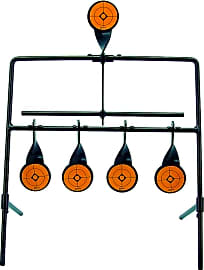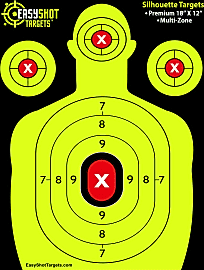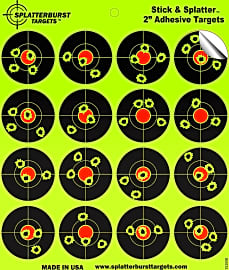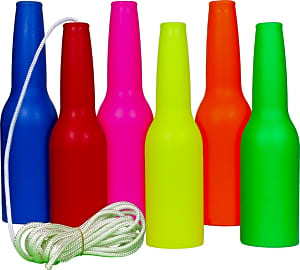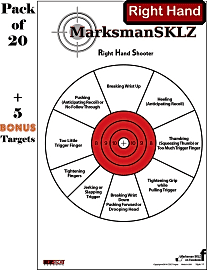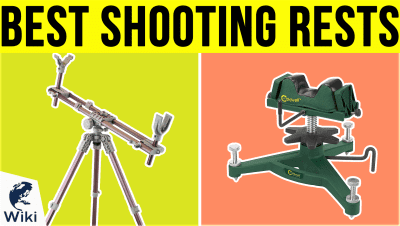The 10 Best Shooting Targets

This wiki has been updated 39 times since it was first published in September of 2015. Practice makes perfect, and you'll never be a skilled marksman if you don't put in serious hours at the range. Of course, to get better, you need to have a reliable indication of how you're performing, which is why it's essential to use high-quality shooting targets. Our selections will help you correct any mistakes, so that you can hone your skills. Use firearms responsibly to avoid injury. When users buy our independently chosen editorial recommendations, we may earn commissions to help fund the Wiki.
Editor's Notes
April 02, 2020:
Removed the Thompson Human Silhouette because of availability issues. Removed the Birchwood Casey Battle because they're not useful as general purpose targets.
Added the Truglo TG12A6 and the GlenDel Buck 3D to reflect broader marksmanship needs.
After using many sorts of paper targets, I have a strong preference for reactive targets like the Splatterburst Silhouette. Splatterburst offer all sorts of bullseye configurations that you can choose depending on the type of shooting that you're doing. Most of my shooting happens between 100 to 300 yards with a bolt-action rifle. It is quite difficult to see shot placement at these distances even with good lighting and a good pair of binoculars. Reactive targets make it much easier to see where your shots are hitting and they help you quickly zero-in scopes even in low-light.
The Champion Redfield can be a great option because of its grid layout which is spaced by inches. This is very helpful when sighting a scope because it tells you exactly how to adjust your scope since the grid corresponds to the gradations on your scope knobs.
Firearms and bows are extremely dangerous and should only be used within an adequate setting while observing all firearm safety rules.
A Brief History Of Competitive Shooting
For most of human history, being able to hit a target with a projectile has truly been a matter of life and death.
For most of human history, being able to hit a target with a projectile has truly been a matter of life and death. If you missed your prey with your spear, your family didn't eat — and if your arrow missed your enemy, you didn't come home to your family at all. As a result, marksmanship competitions have been a staple of both military and civic exhibitions for thousands of years.
The first purely social shooting clubs cropped up in Germany around the 13th or 14th century C.E. Over the next few hundred years, these clubs continued to expand, using both bows-and-arrows and flint-lock muskets.
By the 16th century, rifles were being used. Competitors took aim at festively-decorated wooden targets, and many competitions were held in public, with shooting festivals often hosted on religious holidays or other important occasions.
As settlers began to venture across the pond to America, shooting proficiency became even more important, as potentially-hostile tribes of Native Americans and vicious wildlife were a constant threat. Many communities organized "turkey shoots," with the most-accurate shooter taking home a turkey or similar prize.
Around 1825, Americans pioneered the use of trap shooting, using live pigeons. A few years after that, artificial targets were introduced using glass balls filled with feathers, which no doubt looked incredible when they shattered.
After the Civil War came to an end in 1865, a pair of Union officers lamented the poor marksmanship exhibited by both sides. The two men would go on to form the National Rifle Association, with the express intent of training the next generation of shooters to be better aims than their fathers.
This time also saw the rise of dedicated, professional marksmen (and women) — people like "Buffalo" Bill Cody and Annie Oakley, who both made a living touring the country and putting on shooting exhibitions.
International events began to spring up around the turn of the 20th century, with men's shooting being one of nine competitions at the inaugural 1896 Olympic Games. Ever since those first Games, shooting sports have always been the first to be awarded medals, because the entrants are both armed and impatient.
Today, shooting competitions are held year-round, both formally and informally. If you want to test your prowess as a dead-eye, you can likely find a venue not far from where you live that will let you put your skills to the test.
Just remember, though: in every contest, it's not whether you hit the bull's eye that matters — it's whether you have a believable excuse for when you miss the whole target entirely.
Ways To Spice Up Your Next Practice Session
If your practice routine has gotten stale, here are some ways to liven up your next day at the range.
First off, you should know that you don't have to use boring targets. There are a variety of options that can make practicing more fun, including ones with bad guys to shoot at or games like "Battleship" to play. There are even some that glow in the dark, if you want to try a little nighttime shooting (or if you want to host a "Chernobyl Night" party at the range).
First off, you should know that you don't have to use boring targets.
You can also get creative with home-made targets. Anything that pops, like inflated balloons, or makes a huge mess on impact, like soda cans, is always a fun choice.
One fun game to play with friends is Texas hold'em. Simply staple a few cards to the target downrange, then deal two cards face-down to the competitors, who have their backs turned. Then, each shooter flips over their hole cards and fires three shots at the cards on the targets in order to form the best five-card hand.
You can even get a dart board and play a quick round. Same rules apply, or you can make up your own rules (we're not going to tell you what to do — after all, you have a gun).
There's always a way to spice up even a plain target, or to re-purpose old junk you have lying around the house. Even better, you'll discover you can never get a bad Christmas gift again (thanks for the fruitcake, Grandma — I know just what to do with it!).
Quick And Easy Ways To Improve Your Accuracy
If you don't want everyone at the range to know you're a rookie, here are a few tips to quickly improve your accuracy.
The most important thing you can do is not be afraid to ask for help. Chances are, your range holds classes to teach the public everything from basic safety to improved marksmanship, so take advantage of that. Also, you should know that there's nothing a gun aficionado likes more than to tell another marksman how to shoot, so don't be afraid to ask a neighbor, either.
I guess that just means you'll just have to spend even more time at the gun club.
For rifle shooting, the easiest thing to do is to get a high-quality rest and be sure your gun's properly sighted-in. From there, it's simply a matter of practice.
Handgun accuracy is a little harder to come by. There are different schools of thought as to the proper stance, so explore several and find the one that feels most natural to you.
One of the best ways to improve quickly is through dry-fire practice. Many novices flinch or apply too much pressure to the trigger when firing, but by practicing with an empty gun, you can get used to the trigger without the stress of waiting for it to go off. Once you're able to fire without moving the gun, you can move on to the real thing.
Ultimately, however, shooting accuracy is a skill honed by thousands of hours of practice. Once you find your stance and get acclimated to your pistol, you'll have to put in the work to see improvement.
Oh shucks. I guess that just means you'll just have to spend even more time at the gun club.


